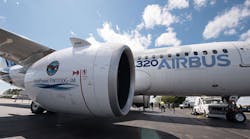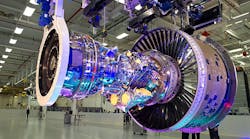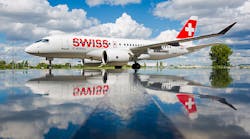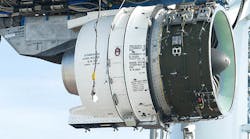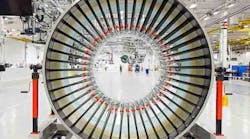Jet-engine builder Pratt & Whitney has cut its 2016 target for deliveries of the PW1000G series geared turbofan engine, indicating supply-chain problems are keeping it from completing on-time deliveries to aircraft builders like Bombardier Inc. Earlier this month, Bombardier reduced its own forecast for 2016 deliveries of the new C Series aircraft – a twin-engine, medium-range jet developed for the single-aisle aircraft market — blaming delays in deliveries of the Pratt & Whitney’s engines.
P&W’s geared turbofan engine is the result of a long research-and-development program reportedly costing $10 billion, It promises to deliver lower fuel consumption and GHG emissions than previous-generation turbofan engines, with reduced noise and lower operating costs. It’s designed with the engine fan separated from the low-pressure compressor and turbine, so that each module operates at optimal speeds.
The PW1000G has been named the exclusive engine option for the Bombardier C Series, as well as for the Airbus A320neo, Embraer’s new E-Jet E2, the Mitsubishi Regional Jet, and the Irkut MC-21 aircraft. Airbus experienced delivery delays for its PW1500Gs earlier this year. Pratt & Whitney has orders for more than 8,000 PW1000G series engines, and reportedly still expects to deliver up to 400 of the engines next year.
In fact, at the same time that the delivery forecast was being reduced, Pratt & Whitney president Bob Leduc said the company might hire up to 25,000 workers in the next decade. Pratt & Whitney already completed an extensive revamp of its Middletown, Conn., engine assembly plant, optimizing production flow for the PW1000G and F-135 engine series.
However, the engine design involves hundreds of individual components, and securing availability of all of them has proven difficult for Pratt & Whitney. Greg Hayes, CEO of P&W parent company United Technologies, told the audience at an investors conference that the company would deliver 150 PW1000G engines this year, not 200 as previously forecast.
Hayes noted there is a particular problem securing timely delivery of the turbine fan blades, which currently take about 60 days to produce rather than 30 days, as expected.
“Nobody’s happy,” Hayes commented, according to published reports. “The airlines aren’t happy they’re not getting the engines. We’re not happy we’re not delivering.”
